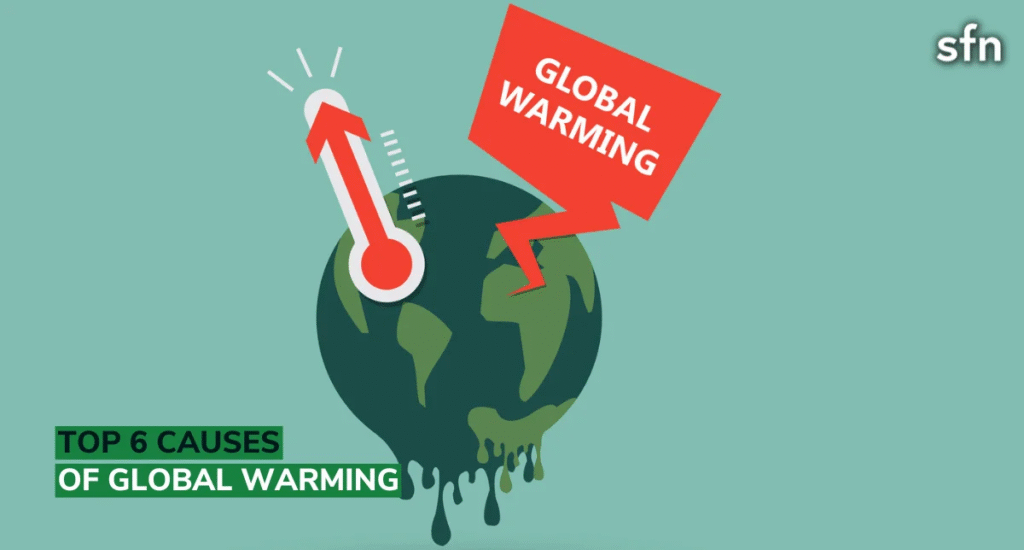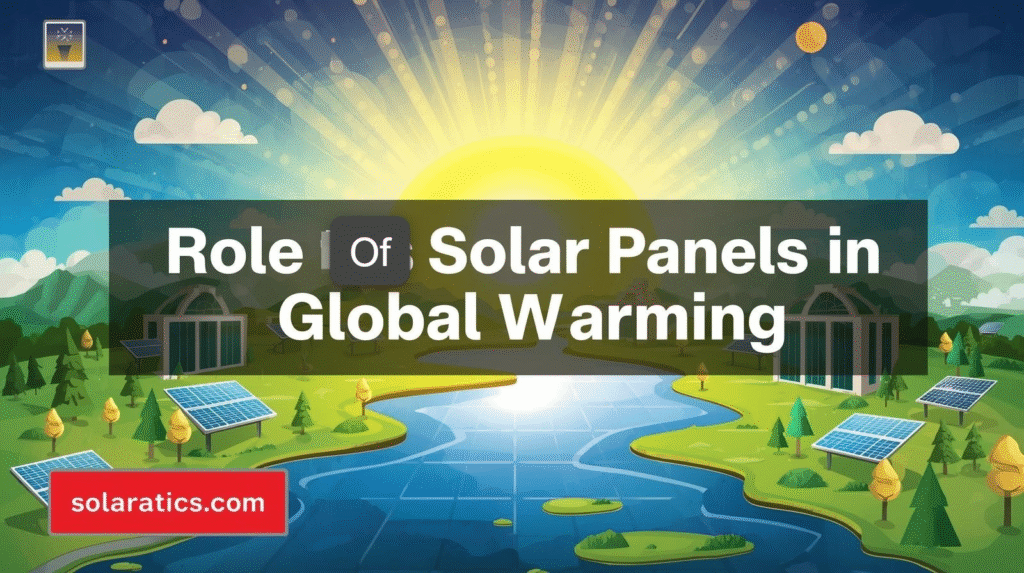Does Solar Panel Cause Global Warming? Key Eco facts Explained

Do solar panels really cause global warming? Learn about their carbon footprint, lifecycle emissions, and true environmental impact on climate change.
Introduction
The fight against global warming has placed renewable energy at the forefront of climate solutions. Among these, solar panels are widely seen as a clean and sustainable way to cut down reliance on fossil fuels. Yet, a question often arises: Does solar panels cause global warming?
While solar energy itself does not produce greenhouse gases during operation, critics highlight the carbon footprint of solar energy, particularly in manufacturing, transportation, and disposal. To truly understand the impact, we must explore the lifecycle emissions, environmental pros and cons, and how solar compares with coal, gas, and other energy sources.

Global Warming
Global warming is the long-term increase in Earth’s average surface temperature due to human activities, primarily the release of greenhouse gases like carbon dioxide, methane, and nitrous oxide. These gases trap heat in the atmosphere, leading to climate change worldwide.
Top 6 Causes of Global Warming

- Burning Fossil Fuels: The largest contributor to global warming is the burning of coal, oil, and natural gas for electricity generation, transportation, and industry. This process releases huge amounts of carbon dioxide (CO2) and other greenhouse gases into the atmosphere, trapping heat and raising global temperatures.
- Deforestation: Cutting down forests reduces the number of trees that absorb CO2 through photosynthesis.Fewer trees remove less carbon dioxide from the atmosphere, intensifying the greenhouse effect
- Agricultural Activities: Agriculture produces significant greenhouse gases such as methane (from livestock digestion) and nitrous oxide (from fertilizers). These gases have much higher warming potential than CO2.
- Industrial Processes: Manufacturing and industrial activities emit various greenhouse gases, including CO2 and fluorinated gases, which contribute significantly to warming.
- Land Use Changes: Besides deforestation, converting land for urban development affects natural carbon storage and contributes to global warming.
- Chlorofluorocarbons (CFCs): synthetic gases, which humans use in refrigerants and aerosols, damage the ozone layer and contribute to warming, although regulations have reduced their use.
These human activities increase greenhouse gas concentrations in the atmosphere, intensifying the natural greenhouse effect, leading to rising global temperatures and climate change. Addressing these causes is critical to slowing down global warming and minimizing its impacts.
Key effects of global warming
Key effects of global warming include rising temperatures, melting polar ice caps, sea level rise, more frequent and intense heatwaves, storms, droughts, and altered weather patterns. These changes disrupt ecosystems, wildlife habitats, agriculture, and human health.
Solar energy plays a dual role in this context: while global warming can challenge solar energy production through increased temperatures and changing weather patterns, solar power is also a crucial solution to mitigate global warming. Solar energy generates electricity without emitting greenhouse gases, reducing dependence on fossil fuels that cause climate change.
Adapting solar technology to withstand and operate efficiently in a warming world is vital for a sustainable energy future. Advanced solar panels improve efficiency in hotter conditions, and resilient infrastructure can better endure extreme weather linked to climate change. Increasing solar energy usage helps slow global warming by lowering carbon emissions and reducing environmental pollution.
In short, global warming causes urgent climate issues, but solar energy remains a key strategy to fight these effects and move toward cleaner, sustainable power.
What Are the Projected Global Temperature Rises By 2100
- Most climate models and scenarios project that global average temperatures will rise between 2°C and 3°C above pre-industrial levels by 2100 under current emissions trajectories.
- High emissions scenarios estimate that warming could reach 4°C to 6°C or more, especially if global mitigation efforts fail and fossil fuel use continues unabated.
- Lower emissions pathways, requiring immediate and aggressive mitigation, aim to limit warming to around 1.5°C to 2°C, but achieving this is increasingly unlikely without significant policy changes.
- Regional variations will be significant, with the Arctic and continental interiors experiencing greater warming than the global average.
- The projected warming range reflects uncertainties in future emissions, climate sensitivity, and feedback mechanisms, but the direction points clearly to a substantial increase in global temperatures.
- Without rapid emission reductions, the risk of severe climate impacts—such as more extreme weather events, sea level rise, and ecosystem disruptions—grows dramatically.
- Current policies globally have the potential to limit warming to about 2.7°C by 2100, but this still exceeds the goals set by international agreements like the Paris Accord.
These projections underscore the urgency of worldwide climate action to reduce greenhouse gas emissions and stabilize global temperatures to avoid the worst effects of climate change
What is The Greenhouse Effect?

- The greenhouse effect is a natural process where certain gases in Earth’s atmosphere trap heat, keeping the planet warm enough to sustain life.
- Sunlight passes through the atmosphere and warms the Earth’s surface; the Earth then emits heat (infrared radiation) back toward space.
- Greenhouse gases absorb some of this outgoing heat and re-radiate it in all directions, including back toward the surface, effectively trapping heat near the ground.
- Main greenhouse gases involved include carbon dioxide, methane, water vapor, nitrous oxide, and ozone.
- Without the greenhouse effect, Earth’s average temperature would be about -18°C (0°F), too cold to support most current life forms.
- Human activities have increased the concentration of greenhouse gases, enhancing this natural effect and causing global warming.
- The enhanced greenhouse effect leads to rising global temperatures, climate change, and disturbances in weather patterns.
This concise explanation captures the core concept and importance of the greenhouse effect for Earth’s climate.
Main Human Activities Increasing Greenhouse Gases

- Burning Fossil Fuels: Power plants, industries, and transportation burn the largest sources of coal, oil, and natural gas, releasing large amounts of carbon dioxide (CO2).
- Deforestation and Land Use Change: Removing forests reduces carbon absorption and releases stored carbon, adding CO2 to the atmosphere.
- Agriculture: Livestock farming produces methane (CH4) through enteric fermentation; use of fertilizers releases nitrous oxide (N2O), and rice paddies emit methane.
- Industrial Processes: Manufacturing activities emit CO2, fluorinated gases, and other potent greenhouse gases used in refrigeration, solvents, and chemicals.
- Waste Management: Landfills produce methane as organic waste decomposes; wastewater treatment also contributes emissions.
- Fossil Fuel Extraction and Processing: Methane leaks from natural gas extraction and pipeline operations increase methane emissions.
- Use of Synthetic Gases: Chlorofluorocarbons (CFCs) and hydrofluorocarbons (HFCs) from refrigerants and aerosols have high global warming potential, contributing significantly despite smaller volumes.
These activities have substantially increased atmospheric greenhouse gases since the Industrial Revolution, driving climate change.
Do Solar Panels Produce Greenhouse Gases?
- Solar panels themselves do not produce greenhouse gases during the generation of electricity; they convert sunlight directly into clean, renewable energy without combustion.
- Manufacturing, transporting, installing, and disposing of solar panels generate greenhouse gas emissions, primarily due to energy use in these processes
- The total lifecycle emissions for solar panels are relatively low, typically around 40 to 50 grams of CO2 equivalent per kilowatt-hour (g CO2e/kWh) of electricity generated.
- This footprint is much lower—about 12 times less than natural gas and 20 times less than coal-fired electricity generation.
- Most solar panel emissions are offset within the first 2–3 years of operation through clean energy produced.
- Over their 25+ year lifespan, solar panels result in substantial net reductions in greenhouse gas emissions compared to fossil fuel energy sources.
- Therefore, solar energy is considered a key technology for reducing global greenhouse gas emissions and combating climate change.
In short, while solar panels have some greenhouse gas emissions in their lifecycle, they produce clean energy without ongoing emissions and significantly reduce overall carbon footprint compared to fossil fuels.
Despite these factors, studies show the lifecycle emissions of solar panels are 95% lower than those of fossil fuels.
Role of Greenhouse Gases in Global Warming
- Greenhouse gases (GHGs) act like an insulating blanket around the Earth, trapping heat in the atmosphere that would otherwise escape into space.
- This trapped heat warms the Earth’s surface and lower atmosphere, causing an overall increase in global temperatures, known as global warming.
- Carbon dioxide (CO2) released from burning fossil fuels accumulates and enhances this insulating effect, leading to more heat being retained.
- Other gases like methane (CH4), nitrous oxide (N2O), and water vapor also contribute to the enhanced greenhouse effect, each with different heat-trapping potentials.
- Human activities such as deforestation, fossil fuel combustion, and industrial processes increase the concentration of these gases, intensifying global warming.
- This warming leads to climate change, including more extreme weather, rising sea levels, melting glaciers, and disrupted ecosystems.
- The increased greenhouse effect is the primary driver of recent rapid climate change and presents major challenges for environmental and human systems worldwide.
In essence, greenhouse gases cause global warming by absorbing and re-radiating heat energy within the atmosphere, creating a warming effect intensified by human emissions.
Lifecycle Emissions of Solar Panels
When considering whether solar panels contribute to global warming, it’s crucial to look at their entire energy lifecycle.
- Production Phase – Mining raw materials (like silicon, silver, and aluminum) contributes to emissions.
- Operational Phase – Nearly zero emissions while producing clean electricity.
- End-of-Life Phase – Waste management and recycling can pose challenges, but technology is improving.
On average, the energy payback time of a solar panel is between 1 and 4 years, while it can last 25–30 years. This means that over its lifespan, the panel offsets many times more emissions than it creates.
How Greenhouse Gases Trap Heat in The Atmosphere

- Greenhouse gases (GHGs) absorb infrared radiation (heat) emitted by the Earth’s surface after it is warmed by sunlight.
- These gases re-radiate the heat in all directions, including back toward the surface, effectively trapping the heat within the atmosphere.
- This process, called the greenhouse effect, keeps Earth’s temperature warm enough to sustain life, averaging about 15°C instead of a freezing 18°C without it.
- The main greenhouse gases are carbon dioxide (CO2), methane (CH4), nitrous oxide (N2O), water vapor, ozone, and industrial gases like chlorofluorocarbons (CFCs) and hydrofluorocarbons (HFCs).
- GHG molecules have asymmetric molecular structures that allow them to absorb and emit infrared radiation very efficiently, unlike major atmospheric components (nitrogen and oxygen), which do not significantly trap heat.
- Human activities, especially burning fossil fuels and deforestation, have increased concentrations of greenhouse gases, intensifying heat trapping and causing global warming.
- The enhanced greenhouse effect results in more heat being retained near the Earth’s surface, leading to rising global temperatures and associated climate changes.
- Different greenhouse gases have varying heat-trapping abilities called Global Warming Potential (GWP); for example, methane traps about 23 times more heat than CO2 over 100 years.
- Water vapor acts as a feedback mechanism, amplifying warming caused by other greenhouse gases because warmer air holds more moisture.
This natural yet intensified greenhouse effect mechanism is the primary driver of current climate change due to increased anthropogenic greenhouse gas emissions.
What are Fossil Fuels?

- Fossil fuels are natural energy sources formed over millions of years from the remains of dead plants and animals.
- They are primarily composed of carbon and hydrocarbons and include three main types:
- Coal: A solid fossil fuel formed from compressed vegetation in wetlands, used mainly for electricity generation and industrial processes.
- Petroleum (Oil): A liquid fossil fuel formed from ancient marine organisms, refined into gasoline, diesel, and other products used for transportation and manufacturing.
- Natural Gas: A gaseous fossil fuel made mostly of methane, used for heating, electricity generation, and as vehicle fuel.
- Fossil fuels are non-renewable, meaning they take millions of years to form and cannot be replenished on a human timescale.
- They have powered human civilization’s energy needs, but are major sources of greenhouse gas emissions and environmental pollution.
- Extraction and use of fossil fuels contribute to climate change, air quality issues, and ecosystem disruption.
This succinct overview explains fossil fuels, their types, formation, and significance.
Solar Panels vs Fossil Fuels: Environmental Impact
| Factor | Solar Panels | Fossil Fuels (Coal/Gas) |
|---|---|---|
| Greenhouse Gas Emissions | Minimal (lifecycle-based) | Extremely high during operation |
| Carbon Footprint | 20–70 g CO₂/kWh (lifecycle) | 450–1,000 g CO₂/kWh |
| Resource Dependency | Sunlight (renewable) | Finite resources (coal, oil, gas) |
| Pollution | Manufacturing waste, recyclable | Air pollution, smog, acid rain |
| Long-Term Impact | Carbon-neutral after payback | Continuous CO₂ release → warming |
Clearly, solar panels contribute far less to climate change compared to fossil fuels.
Do Solar Panels Produce Greenhouse Gases?
- Solar panels themselves do not produce greenhouse gases during the generation of electricity; they convert sunlight directly into renewable energy.
- Manufacturing, transporting, installing, and disposing of solar panels generate greenhouse gas emissions, primarily because these processes use energy.
- Lifecycle emissions for solar panels are low, typically 40 to 50 grams of CO2 equivalent per kilowatt-hour of electricity generated.
- This footprint is much lower—about 12 times less than natural gas and 20 times less than coal-fired electricity generation.
- Most solar panel emissions are offset within the first 2–3 years of operation through clean energy produced.
- Solar panels result in substantial net reductions in greenhouse gas emissions compared to fossil fuel energy sources.
- Therefore, solar energy is considered a key technology for reducing global greenhouse gas emissions and combating climate change.
In short, while solar panels have some greenhouse gas emissions in their lifecycle, they produce clean energy and reduce overall carbon footprint compared to fossil fuels.
Role of Solar Panels in Global Warming

Clean Energy Generation
Solar panels generate electricity by converting sunlight directly into energy without burning fossil fuels. This process emits no greenhouse gases (GHGs) during operation, making solar energy a clean, renewable power source.
Reduction of Carbon Footprint
Solar panels emit 12 to 20 times less CO2 per kWh than natural gas and coal power plants, despite some emissions from their production and installation.
Life-cycle emissions are roughly 41-50 grams of CO2 per kWh, which are offset within the first 2 to 3 years of use by clean energy production.
Offsetting Manufacturing Emissions
Solar panels quickly offset the carbon from production and transport, leading to major greenhouse gas reductions over their 25+ year lifespan.
Supporting Decarbonization Goals
Increasing solar panel capacity is vital to achieving climate goals such as those outlined in the Paris Agreement.
By 2050, solar is projected to provide a significant share of electricity globally, drastically lowering GHG emissions from the power sector.
Environmental Benefits Beyond Carbon
Solar panels also reduce air pollution, water usage, and habitat disruption compared to conventional power plants. This helps mitigate broader environmental damage associated with fossil fuel extraction and combustion.
Economic and Energy Security Advantages
Solar energy decreases reliance on imported fuels, stabilizes electricity costs, and creates green jobs, supporting sustainable economies while contributing to global warming mitigation.
Challenges and Future Prospects
Ongoing improvements in solar panel efficiency, recycling, and cleaner manufacturing processes will further reduce their environmental footprint and enhance their role in combating global warming.
In short, solar panels play a crucial role in combating global warming by providing low-carbon electricity, significantly reducing greenhouse gas emissions, and supporting sustainable energy transitions worldwide.
Are Solar Panels Truly Eco-Friendly?
Yes, but with considerations. While solar energy drastically reduces carbon emissions, there are environmental concerns:
- Solar panel waste problem – End-of-life disposal may cause e-waste if not recycled properly.
- Land use – Large solar farms may disturb ecosystems.
- Manufacturing pollution – Industrial processes still rely partly on fossil energy.
Still, when compared with the massive CO₂ emissions of coal and gas, solar panels are far more eco-friendly.
Conclusion
So, do solar panels cause global warming? The answer is no—at least not in the way fossil fuels do. While there are minor lifecycle emissions from production and waste, the overall impact of solar panels is overwhelmingly positive for the environment. By replacing coal and gas, they reduce greenhouse gases, lower the carbon footprint, and support a sustainable, carbon-neutral future.
Switching to solar is not a cause of global warming, but rather a powerful solution against it.
FAQs
No, solar panels do not emit greenhouse gases during their operation. They generate clean electricity by converting sunlight directly into energy without combustion or pollution.
Yes, by replacing fossil fuel-based electricity generation, solar panels significantly reduce carbon dioxide and other greenhouse gas emissions, helping to combat global warming.
There are some emissions associated with manufacturing, transportation, and installation of solar panels, but these are minimal compared to the emissions avoided by their clean energy output over their lifespan.
Solar panels typically pay back their carbon footprint within 2 to 3 years of operation by producing clean energy that displaces fossil fuel emissions.
While solar panels reduce greenhouse gas emissions, the localized effect on temperature varies depending on installation scale and location. Globally, widespread adoption of solar power contributes to cooling the planet by reducing emissions that drive warming.
